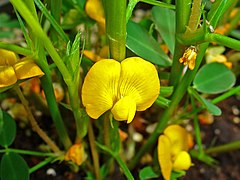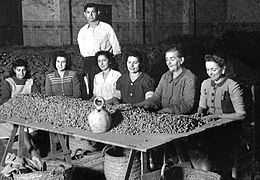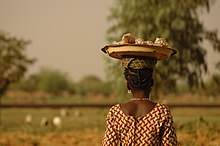Arachis hypogaea
Arachis hypogaea, commonly known as peanut, peanut, peanut or Peanuts is a plant of the Fabaceae family. It is cultivated for its edible seeds.
Description
It is an annual, erect or ascending-stemmed herb 30-80 cm tall, with yellowish, glabrous, pubescent stems. Stipules 2-4 cm, hairy. Leaves are generally four-foliolate with a 4-10 cm petiole, covered with long flexuous trichomes, with ciliated margin and apex. Flowers 8-10 mm with narrow calyx tube 4-6 mm. Corolla golden yellow; open banner and distinct wings, oblong to ovate; keel distinct, very ovate, shorter than the wings, with a pointed apex. Ovary oblong with the style terminated by a small stigma, sparsely pubescent. The fruit is a legume, but considered a dry fruit, of underground development, oblong, inflated, 2-5 × 1-1.3 cm, thick-walled, reticulated and veined, with one to four (less than six) seeds. The latter have a dark reddish integument, are oblong and about 5-10 mm in diameter.
A unique characteristic of this plant is that, once the flowers have been pollinated, they wither and generate a "nail" that goes to the ground and buries the bud that will later become the pod ("box"). containing the fruits. In other words, the peanut matures underground, but is not attached to the roots.
Origin
Genetic origin
A genetic study published in 2016 has revealed that peanuts are a hybrid of two wild species. It originated from the crossing of the ovule of A. duranensis (distributed in southern Bolivia and northern Argentina) with pollen from A. ipaensis (currently conspecific with A. magna, which grows and is distributed in the Brazilian rainforest). This hybridization occurred hand in hand with human collection and migration, as well as natural insect pollination, some 9,400 years ago, in the current sub-Andean region of southern Bolivia (Chuquisaca and Tarija).
The seeds of these hybrids were collected by the ancient inhabitants of these regions and taken northwest across the Andes Mountains.
History
A. hypogaea has been cultivated for the use of its seeds for seven or eight thousand years. The oldest remains of this seed date from the year 6494 BC. C., found by the American archaeologist Tom Dillehay in Paiján and in the Ñanchoc valley (present-day Cajamarca, Peru) in the upper part of the Zaña river, a valley that turned out to be the oldest cultivation place in America.
The inchik (the name of the seed in Quechua) was consumed and represented from the oldest cultures and cities of America. They were used in gastronomy: lagua or inchik milk, and inchicapi, which were fresh chicha and soup respectively. The inchik was chiselled into some statues of deities in the temples of the Chavín civilization (approximately 1200 BC) in west-central Peru..
Introduced to Mesoamerica from at least the 1st century BCE. C., according to the record of Tehuacán (state of Puebla, Mexico), where it was called tlalcacáhuatl (in the Nahuatl language, 'cocoa of the earth'). It became part of the ingredients to prepare mulli or mole, a mixture to offer to the great Mesoamerican gods. On the other hand, in the Caribbean islands, this seed was called, in the Taíno language, peanuts.
Later, in the Early Intermediate period (200 BC-700 AD), the shape of the shell (pod) of the seed was used artistically, such is the case of Mochica jewelry in anthropomorphic representations in gold, silver and copper, such as the necklaces of the Lord of Sipán (the beads on the necklace were gold and silver inchik pods), in the 3rd century.
A thousand years later, in the Late Horizon, the Incas used the oil extracted from the inchik mixed with the oil of a kind of ointment tree, using the result for skin protection.
The Spanish conquistadors learned about the consumption of this seed when they arrived in the American continent while visiting a market in the Aztec capital, Mexico-Tenochtitlan, in the 16th century.[citation required]< /sup> In Europe its cultivation entered through Spain, specifically Valencia, where it continues to be one of the main agricultural productions. The trade of the European powers of the Modern Age introduced the seed to other continents.
Scientist George Washington Carver (1864-1943) proposed peanuts (among other plants) for the agricultural industry in the first half of the 20th century as part of his concept of agricultural extension and alternative crops for global self-sufficiency. He created or disseminated more than one hundred peanut products that were useful for the home and farm, including cosmetics, dyes, paints, plastics, gasoline, and nitroglycerin.
Currently, its cultivation has spread widely throughout regions of Asia, Africa and Oceania.
Cultivation
It is sown in late spring and harvested in late fall. Its cultivation has been carried out since ancient times, as indigenous peoples cultivated it, as reflected in the archaeological discoveries made in Pachacámac and other parts of Peru. There, representations of the inchik were found on pieces of pottery and vessels. In Africa, it spread rapidly and became a staple in the diet of many countries, which is why some authors erroneously place the origin of peanuts on this continent. The shells, obtained as a by-product, are used as fuel.
Today, the main countries of cultivation are China and India, where it is mainly used as a raw material for the production of "peanut oil".
Pests
Infection by certain species of fungi (Aspergillus flavus or A. parasiticus) contaminates the seeds with aflatoxins, dangerous carcinogenic substances.
In Argentina, a serious problem that is beginning to worry specialists is the appearance of peanut smut, caused by Thecaphora frezii.
In a paper presented in June 2008 by Marinelli, A.; G. J. March and C. Oddino, summarized as follows:
The coal was first detected in mani cultivated in the 1994/95 campaign, and since then it has been observed in isolated lots and with low incidence. Considering the importance of this crop for Córdoba, and that 80% of the production is destined for export, biological and epidemiological aspects of the disease were studied. To determine sites and form of infection (Koch particles), inoculations were made to flowers and soil and partially affected and externally contaminated seeds were sown. To quantify the disease, lots (prevalence and incidence) were monitored in seven agricultural campaigns, and a methodology was developed to detect the pathogen in soil samples. It is concluded that Thecaphora frezii is the cause of the charcoal of cultivated peanuts and that the infection is located in the gynophorus when it enters the soil. The only colonized organs are fruits and seeds, which can be transformed into a carbon mass. Dispersion occurs through sick or externally contaminated seed. Pathogen survives on the ground and can be detected by sampling and microscope observation of teliospores. The prevalence ranged between 9-24 percent of monitored lots, and the incidence between 0.13 and 2.7%; a lot with incidence was detected 6.4%.
Name
Peanut is a word of Taino origin and is the name that predominates in some Spanish-speaking countries for the denomination of both the plant and its fruit and seed. The name maní can also come from the Guarani language in which it is called manduví.
The term cacahuate is a Nahuatlism from cacáhuatl ('cocoa'). In Nahuatl, it is called tlālcacahuatl, which means 'cocoa of the earth', composed of tlalli ('earth', 'soil') and cacahuatl ('cocoa beans'), because the pod of its seeds is underground. In fact, in Valencia, the first place where it was cultivated in Europe, it is still called cacao (cacau in Valencian).
The plant and the fruit are known in Mexico as cacahuate, while Spain has adopted the word cacahuete, and in most of the Region of Murcia and Andalusia the fruits are generically called hazelnuts. In some parts of Spain, the peeled and fried fruits are called panchitos or manises (in the Canary Islands and in the towns of Vigo and Chapela, in southwestern Galicia).
His name is inchik in the Runasimi language, and chuqupa in Aymara.
It is also called ground pistachio, American hazelnut, Valencia hazelnut or ground pistachio.
Uses
Food such as cream or peanut butter is obtained from this fruit, and its oil is extracted, widely used in the cuisine of India and Southeast Asia.
In Spain, the seed is eaten raw, fried or toasted, although it is often popularly known as "cacahuetes" or "cacaos".[citation required] In Andalusia Occidental, they are usually called "hazelnuts".
In the Canary Islands, they are known as "manises".
The roasted seeds are used to make a coffee substitute.
In Ecuador, the Transkutuku Peanut designation of origin was protected.
It can be eaten as an appetizer (usually roasted and salted or added with chili/chili powder to give it a spicy flavor) or as part of cakes and sweets (usually as a garnish on donuts or as a topping of ice creams).
Shell
Of concave geometry, its thickness varies from 0.5 to 1 mm. It has a high weight/volume ratio of 45-50 g/L.
The chemical composition has a wide dispersion (according to the variety analyzed), so approximations can be generalized. Humidity: less than 10%; crude fiber: about 60% (cellulose: 50%); lignin: 25%; glucan: 20%.
In the preparations in which the peanut is eaten fried inside its shell, it is not necessary to discard it before eating, since it softens with cooking and acquires certain edibility conditions.
Use as waste
The peanut shell is a waste that is reused as fuel for boilers, although its use is somewhat difficult because it gives off a lot of smoke and ash.
It is partially used to mix with livestock feed, especially pigs. Although it has no protein value and is indigestible, it serves to manage the material balance of other types of food with which it is mixed.
It serves as a substrate for poultry and as a culture medium for mushrooms.
It is also associated with uses similar to those of wood shavings. At the National University of Río Cuarto (Córdoba, Argentina) mixed agglomerate panels were developed with peanut shells (30%) and wood shavings.
World production
According to data provided by the United States Department of Agriculture, world production of peanut oil has remained stable in the five-year period 2011-2015.
| Production (millions of metric tons) | 2011/12 | 2012/13 | 2013/14 | 2014/15 | August 2015/16 | September 2015/16 |
|---|---|---|---|---|---|---|
| Mani | 38,47 | 40,47 | 41.15 | 39.67 | 41,39 | 40,78 |
Source:
Foreign trade in peanuts
Evolution of the main peanut exporters in the world
The United States, the Netherlands and China were the world's three largest peanut exporters in the five-year period 2010-2014.
The figures presented in the table below are in US dollars FOB value.
| Date Exporting country | 2010 | 2011 | 2012 | 2013 | 2014 |
|---|---|---|---|---|---|
| United States | 220 477 696 | 220 526 347 | 268 434 982 | 543 585 640 | 450 778 162 |
| Netherlands | 171 456 595 | 242 856 996 | 155 818 516 | 271 798 633 | 238 893 982 |
| China | 234 577 355 | 218 762 794 | 244 212 798 | 215 666 317 | 195 535 976 |
It can be seen that, during the 2013-2014 biennium, the United States exceeded the combined exports of the Netherlands and China. Within South America, Argentina and Brazil led the list of exporting countries. Nicaragua was the only major exporter from Central America. India, Egypt, Israel and South Africa completed the list.
Evolution of the main peanut importers in the world
On the other side of the trade balance, the Netherlands, Germany, and Mexico were the world's top importers of peanuts during the years 2010-2014. It is clearly marked that the Netherlands equaled the combined imports of Germany, Mexico, and the United Kingdom.
The figures presented in the table below are in US dollars FOB value.
| Date Importing country | 2010 | 2011 | 2012 | 2013 | 2014 |
|---|---|---|---|---|---|
| Netherlands | 337 280 601 | 429 645 642 | 571 446 231 | 587 955 792 | 484 708 924 |
| Germany | 137 250 765 | 183 349 355 | 202 066 229 | 205 195 023 | 212 954 707 |
| Mexico | 129 783 369 | 182 050 961 | 221 608 422 | 147 369 833 | 152 516 191 |
The list was completed by the United Kingdom, Russia, Canada, Spain, Italy, Malta and Poland.
Growing in China
It was introduced to China by Portuguese merchants in the 17th century and other varieties by American missionaries in the 19th century. It became popular and began to be made into many Chinese dishes, often boiled. Already in the 20th century, during the 1980s, its production began to increase; so much so that, in 2006, China was the world's largest peanut producer. An important factor in this increase has been the shift from the communist system to a free market economic system where farmers choose what to plant and what to sell.
Properties
Active ingredients
Contains amides, sugars, choline, araquine, oil (oleic, palmitic, stearic, arachidic, myristic and lignoceric acids, as components), proteins, betaine.
Indications
It is nutritious, fluidifying, anti-cholesterolemic. The flour is used for products intended for diabetics (cookies, nougat). The fruits are used. They are harvested in September.
Some people should avoid it, as it is allergenic and also contains fiber.
It has high levels of aflatoxin, a mycotoxin from some fungi that can be dangerous to health.
There could also be the possibility that (being a legume that is eaten raw) its lectins cause atherosclerosis. However, it is also suggested that it can improve the lipid profile. As there is no clear evidence in any direction, it is recommended not to abuse its consumption.
In turn, despite being high in calories, and according to multiple studies, both peanuts and nuts are appropriate for losing body fat and achieving or maintaining a healthy body composition, thus avoiding obesity.
It could also help strengthen the brain and memory by regenerating neurons,[citation needed] thus decreasing the risk of developing Alzheimer's disease (as do all dried fruits).
Taxonomy
Arachis hypogaea was described by Carlos Linnaeus and published in Species Plantarum 2: 741. 1753.
- Sinonimia
- Arachis hypogaea subsp. oleifera A.Chev.
- Arachis nambyquarae Hoehne
- Lathyrus esquirolii H.Lév.
Contenido relacionado
Bothriochloa
Arundinaria
Andropogon



















